m-onz
11.11.24
history of fake[dac~]
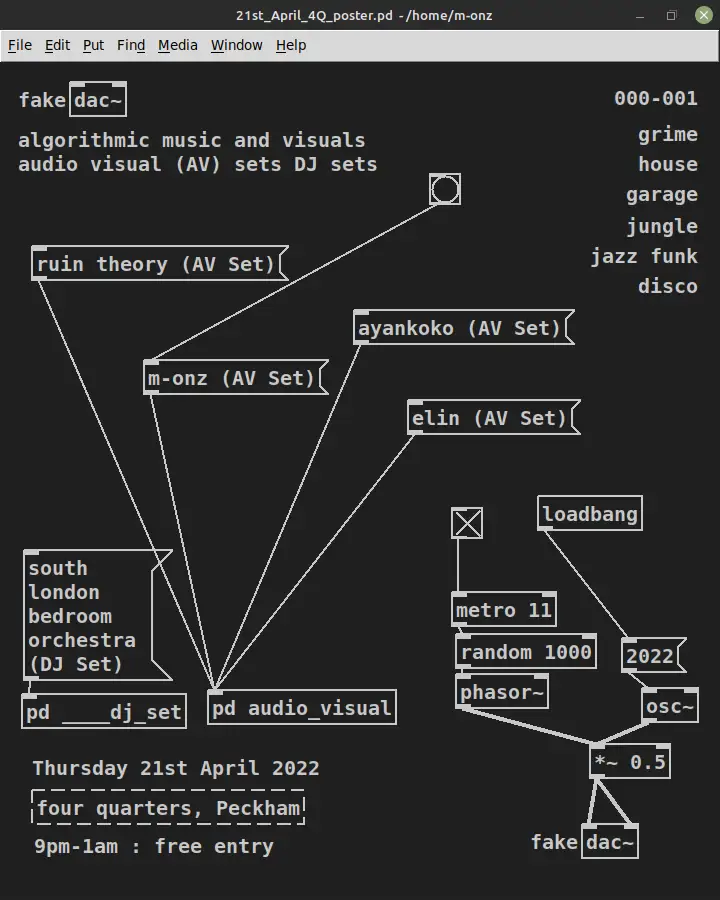
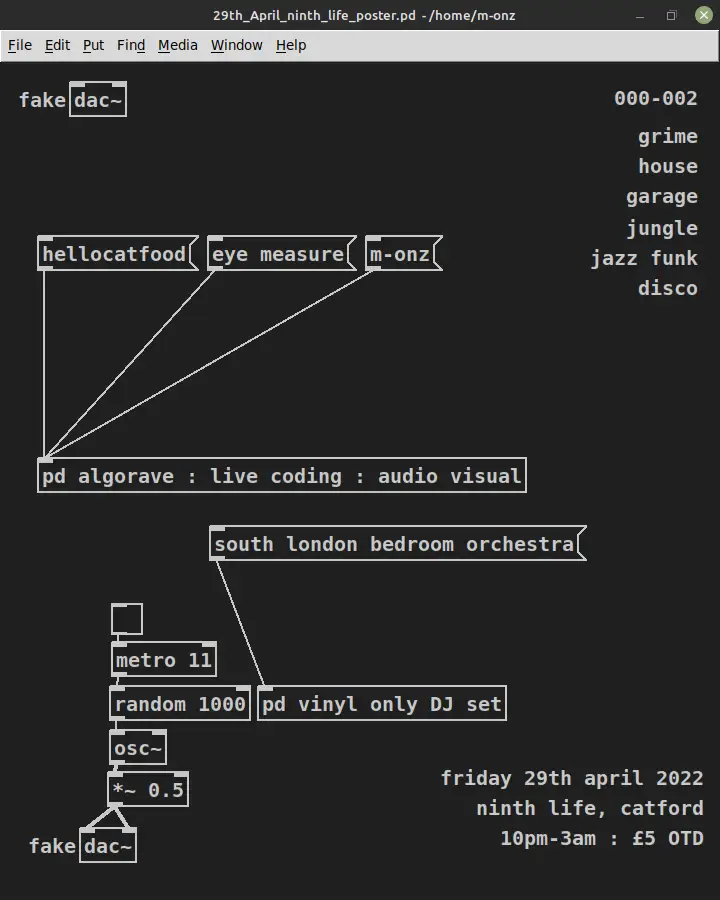
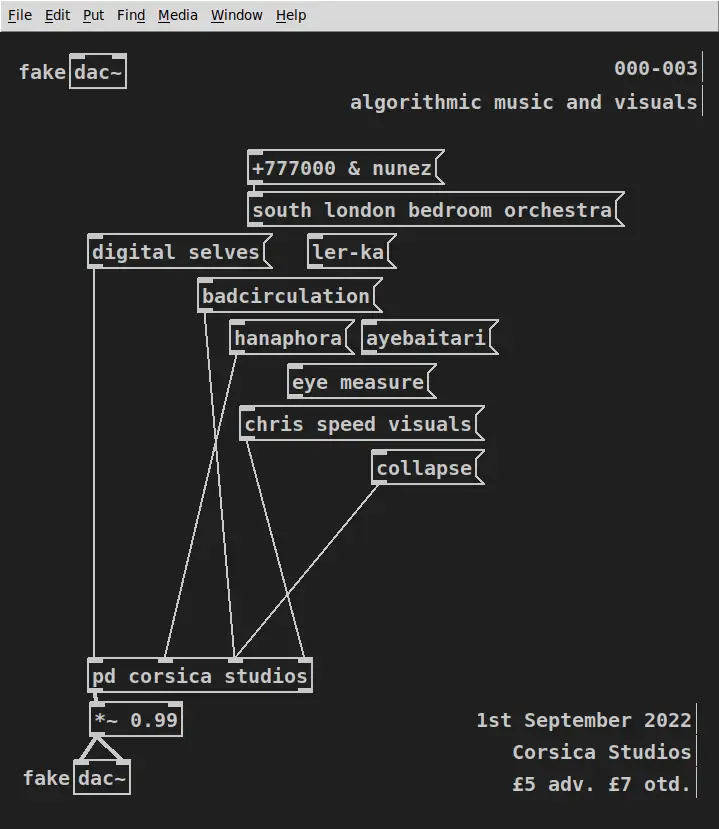
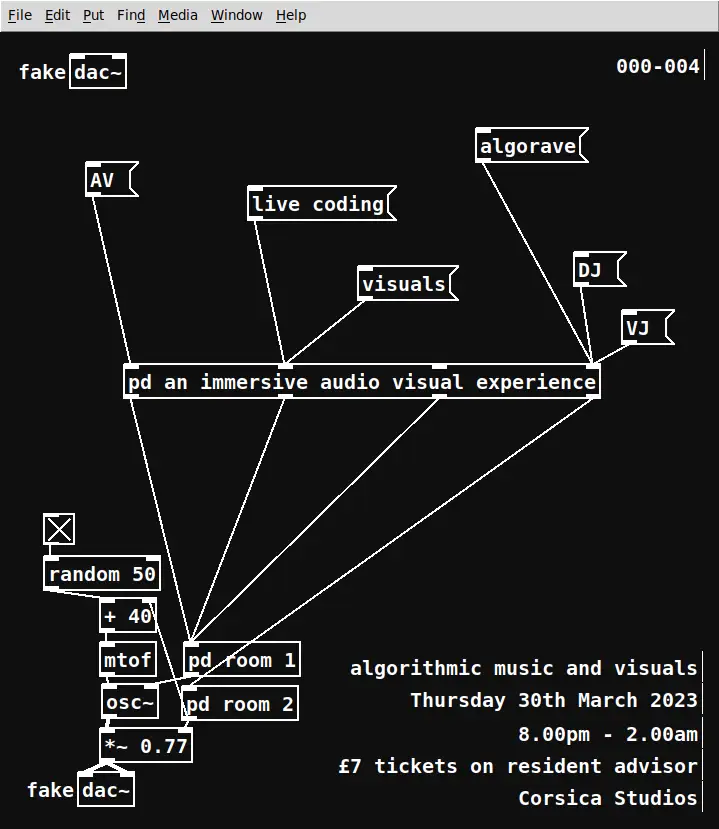
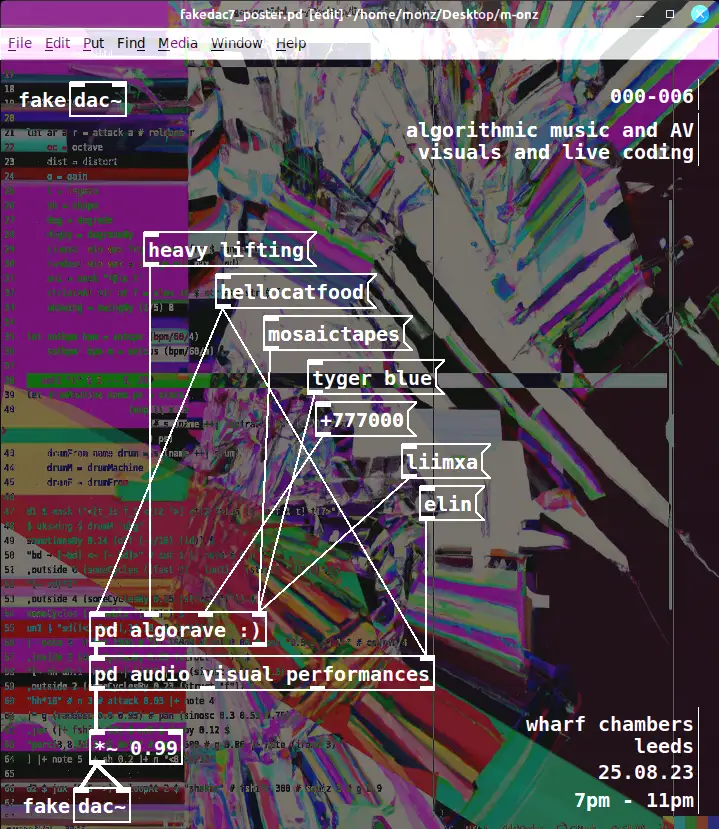
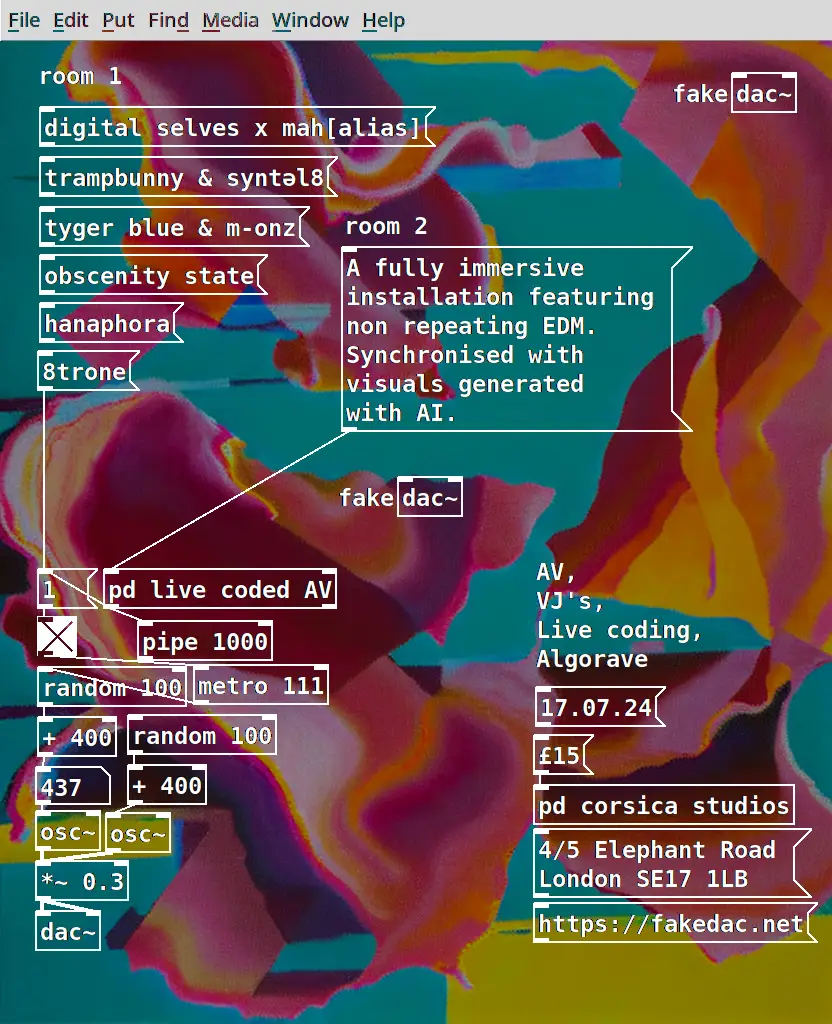
a brief history of fake[dac~]
I found myself in the the audio visual, algorave and VJ scene. The event I created called fake[dac~] started because my good friend Luis Sanz was planning a UK tour in 2022 so I booked a room in a small basement club in peckham : https://ra.co/events/1500094.
I have spent an obessive amount of time doing music, mad science. I'm a self taught software engineer developer, hacker, multi-instrumentalist, VJ. Not exactly extrovert or interested in most aspects of modern gen-Z culture as a bit of a privacy nut. I don't use any personal social media and go through stints of using a "dumb" phone and living under a rock. Never in a million years would I have imagined being an event organiser, curator and AV artist in an exciting scene building in London and globally.
Luis Sanz was unable to actually make the first three fake[dac~] gigs because of visa or lockdown issues. The gigs still went ahead and although there was an atrociously low turnout. I found that I enjoyed the process, met some cool people and knew more about AV, algorave and the scene than I realized.
I had booked another gig in a room above a pub in catford (where I live) with equally appalling turnout that Luis Sanz also could not attend due to lockdown :https://ra.co/events/1506633 but at this point I had really caught the event organising bug. The event brand and pure data canvas patch cable posters that I just randomly thought would be cool started to have it's own unique appeal.
The instagram started to pick up followers, a directory of artists was building up and my benevolent dictator curator streak was starting to form. I have a very clear idea of what I want and still want which is "dance floor & club orientated" algorave & AV. I want it to sound exciting like the chemical brothers but made with code. I'm less interested in what I facetiously call "arty farty" stuff that I always felt was just too easy. It's actually much more difficult to make algorithmic: drum and bass or algorithmic dubstep for example than 20 mins of white noise. This is what I want people to start performing because eventually a new genre or new genre's would form that would make DJ culture look boring.
I have always felt culture stagnating after the exciting rave scene of the 90's. We have been narcistically and self indulgently regurgitating it ever since. I have a very low opinion of all modern "pop" music and DJ music tech gear obsessed culture. All the gear but no idea... style over substance. A cargo cult of epic proportions to sell DJ magazines, overpriced tickets. Ibiza being the perfect example of this trite and hollowed out rave culture (not that I've ever actually been to ibiza).
That isn't to say there isn't interesting DJ culture and music at the fringes, audio visual and VJ scenes feel sporadic and largely uninteresting. Definitely not mainstream... the word AV is more likely to evoke the thoughts of installing conference calling equipment in offices for zoom calls than what I think of as AV (audio visual) art.
There was briefly a very interesting blip I would say in around 2011 when "projection mapping" was new and exciting. This was before it got swallowed up by the advertising & fashion industry to sell products and make glitzy events look "current" and on trend.
meeting Luis Sanz
While at Uni I was fired from a job VJ'ing for a well known drum and bass event at a large venue (for mixing business with pleasure). I was essentially VJ'ing pre-existing content at ground hog day style event. The name of the event must be plastered on the walls at all time lest for at any moment any of the ravers forget at which event they were at. I had also VJ'ed at some squat raves and small clubs in and around Cambridge. In 2011 I had a vimeo account where I was also doing some projection mapping on planks of wood.
I made some tiny cubes using an origami method of folding up thin card using a template and stacked them up in my room. The weird thing is that the video's did not show a sense of scale so when I got an email from le zoo (a club in switzerland) asking me to do projection mapping for a drum and bass event for Alix Periz and Icicle. Maybe they didn't realise my projection mapping was actually on tiny models and wooden planks.
It mattered not, for on that fateful day in 2011 I was flown to Geneva to ultimately VJ. I disappointed them when I said that I was actually not planning to do any projection mapping. I had some generic VJ software like resolume. I had very little content made entire with processing (processing.org)... spinning cubes.. that kind of thing.
thou shalt not use kaleidescope
The *other* VJ booked for that night was Luis Sanz (Indefinite VJ), who had an insane amount of content and his style, professionalism and approach made a huge impression on me. I had a spiritual experience with light from the sky lights raining down and a small voice in my head said: "you are a VJ, this is where you belong." Or something to that effect. It was an amazing experience including random chats decadent drum and bass DJ's and even VJ groupies trying to stand next to me in the VJ booth area before being stolen away by security.
Since then I visited Luis to follow him around and help him with his gigs, he kindly shared his booking fee with me and I remember after a party on the final night of one of my trips there. All his friends had a whip round to give me spare coins so I was able to afford to travel back to the airport. I couldn't afford the train so I had an awkward interaction with a ticket collecter. I was consistently skint at uni for various reasons. On that particular trip when I was back in the UK I was crying in my car because I had no money and petrol to get back to Cambridge when a stranger knocked on my window and gave me enough money to get back.
the VJ, AV and advertising boom
The VJ scene and projection mapping scene was briefly new and exciting but eventually became assimilated by advertisers to sell fizzy drinks at tacky promo events. There was also a fad of projection mapping on buildings. I made some content that was projected onto a castle in kent during this time. There was also the proliferation of the microsoft kinect camera. That meant that 3D scanning, skeleton tracking using C++ frameworks like openframeworks became feasible to artists.
Advertisement and other commercial avenue's have successfully sucked the life out of VJ'ing and AV. There are large festivals that use large LED screens and visuals but they are largely superfluous to the music. The music artists are the people that get green rooms, large booking fee's. VJ'ing and AV has always been and still is a hidden aspect. Largely filled by anonymous engineers and technicians in black t-shirts up ladders and fumbling around with wires.
Amon Tobin and deadmau5 were famous at the time and had a visual element but it was largely in the "arty farty" category because Amon Tobin was playing pretentious sound design / film score type stuff using projection mapping to make it less like watching paint dry. Deadmau5 represented the degeneration of DJ culture completely... having to embrace novelty completely and wear a ridiculous mouse head and shine lazers in people's eyes to maintain his brief relevancy. DJ culture and music culture has got much, much worse since then but this felt like an interesting turning point.
the algorave scene
During my time at university at ARU in cambridge I had encountered the algorave scene at it's origin, played around with SuperCollider, max/msp and pure data as part of my studies in music tech & algorithmic music. I never really went to these early algorave gigs to be honest. The conversation about whether a laptop really is a good musical instrument was discussed a fair bit. "laptop orchestras" appeared like LorK and toplap was emerging.
The algorave scene was quietly building in the background during this time. The strength and amazing vision of Alex Mclean to make algorave incredibly inclusive was and still is a breath of fresh air. Especially in today's duplicitous and brittle music culture where things fall in and out of favour with superficial melee.
In the algorave scene newcomers were welcomed and allowed to develop. Long repetitive sets and experiments were greeted by lovely and accommodating audiences. A huge variety of abilities, approaches and music and visual output were celebrated. It actually brings a tear to my eye but as you might expect it was initially niche. Then kind of on the fringe but this scene was quietly becoming international and widely respected.
This is an example of a scene with substance over style, something new to say and offer. Full of amazing people that will talk your ear off with enthusiasm and who would give you the clothes off their back to help anyone presenting the vaguest curiosity or interest.
the 10 years algorave : corsica
Just before my first fake[dac~] I attended the 10 years algorave at Corsica: https://ra.co/events/1499155 It was an exceptional event. It featured the cream of the crop of the algorave scene including an extremely memorable installation piece from Michael Jon-Mizra. Ultra bright short throw projectors borrowed from goldsmiths university and a fantastically engaged crowd.
This may have been one of the reasons that I got inspired to start my event brand and I head hunted many artists from the algorave scene for my events. There were some performers that wouldn't align with my vision but a few that really exemplify it like hellocatfood. Who not only is probably the best VJ in the scene using Pure data and GEM. He is also a brilliant tidal cycles live coder (all round nice guy) and audio visual artist. Crucially his set's sound club orientated and more recently invoking music indistinguishable from 90s rave : ).
The medium of live coding and presenting the code to the audience took a long time to gestate but I think the 10 years algorave was a crucial milestone. The maturity and sophistication was palpable and the audience was probably largely made up of entertained onlookers & those sparked with inspiration to become artists, start events or build their own algorithmic systems.
observations of algorave
One observation I would make about algorave is that it doesn't have a uniform musical genre, visual style, fashion or approach. It's an incredibly broad church with as much emphasis on "how" something is done as much as "what" is done.
I believe this is unique in music culture because previously glam rockers had the glam look. Jazz artists had their in jokes and bebop language and look. I don't want to enumerate more example but you get the idea. Algorave is weirdly free from this kind of obvious typecasting and stereotyping. You couldn't look at a crowd at an algorave and immediately know based on fashion that you were there.
The main characteristics are code and visuals prominently displayed via projectors and laptop artists looking pensive and sometimes static. Checking for syntax errors in their code and hoping their laptop doesn't crash which the audience are both entertained and intrigued. The audience inherently know that this is a new and novel evolution in culture and appreciate the experience more than cookie-cutter DJ centric events that I find mostly lifeless.
great artists steal
Having witnessed the 10 years algorave anniversary event and a few other events put on my the computer art students from Goldsmiths at Corsica I wanted to have fake[dac~] at Corsica Studios. It has two rooms, an amazing sound system and suitable for audio visuals. Both rooms can have 3 projector screens but room 2 has a lower ceiling which makes it more challenging.
Somehow by some twist of fate I was given a date to do a fake[dac~] at Corsica in September 2022. I only used one room, combined DJ's & VJ's with AV and live coders and picked the live coders who really impressed me to play. Amazingly these live coders and artists are friendly and willing to play for £150 for 30 minutes. Compare that to your diva DJ expecting a limo and a jar full of only blue m and m's working with live coders is a breeze.
Live coders typically just have a laptop and soundcard with a HDMI port. For this first event I had a table in the centre of the room full of laptops. A single projector with a cable hanging down... it felt like a hackspace more than a club night. It's amazing no-one tried to grab and steal a laptop or worse but the event was a success and allowed me to book future events at Corica Stutios.
all the gear and no idea
DJ culture is absolutely bizarre, pressing play of a CD player. Looking cool and aggressively courting the fickle masses. The fickle masses are oversaturated with music already and need ever increasing coercion. The DJ's are using over engineered CD and mp3 players that flash like the control panel of a space ship or Christmas tree.
The live coders have a laptop that is generating electronic music in realtime. It's actually live.. fraught with potential risk. Deafening the audience accidentally with a single misplaced line of code or parameter value. Creating a sine wave that breaks the speakers, this risk makes me excited and at the 10 years algorave that fear intrigued me and followed me the entire evening. I was so amazed that at no point did that happen. I couldn't be in both rooms at once and I know one of the performers put the speakers through their paces with a custom C++ audio engine.
The "gear" heads largely make self similar music, obsess about buying hardware, plugins, software and sample pack. "What does this thing do?" - you will ask... "Oh it's not plugged in". This is a kind of voyeurism of music making. Style and substance can be immediately bought for money... it becomes addictive because for a brief second you feel talented and it's all worth it.
counter intuitive
It seemed counter intuitive that the free difficult thing was the better path. The shiny toy, VST and pull of the mass music tech masses is intoxicating and magnetic. You think that the expensive constantly moving goal post and social norm is the good way. The lonely and difficult path, with steep learning curves that doesn't make music that sounds as good (initially) that hardly anyone else explores does not seem like a good strategy.
The algorave scene took more than 10 years to grow and develop amazing artists that make music that sounds better than the coolest and hippest hyper music you can think of. Its all actually live and they are evolving further. Soon music producers will decide that live coding is a better option for success than main stream music production techniques.
swimming against the stream
Given enough output the system or process involved in a creation will become more apparent. A series of producers using the same tools, plugins and instruments will find it ever increasingly difficult to create unique or interesting output without more effort and novelty.
However if you create your own algorithmic process it is initially difficult as you learn a suitable language or multi-media programming language. Then a tipping point occurs.. when the tool is mastered the frequency, productivity, range of output expands the horizons of the wise and faithful. It becomes much easier to make original and distinct output at a faster frequency. It becomes easier to develop.. and I don't know about you but I don't want to sound like other artists and regurgitate other peoples art.
the true faith of open source
I am not so close minded as to say you should use x technology over y. Technology can be used in any configuration and it can be made to achieve your vision. I would just offer my warning about the false progress of "paying" for tech.
Open source is not as polished but it has the benefit of being free. Pure data is a great example of a multi-media programming language and environment limited only by your imagination. It's stable, static and once you master fundamentals open's you up to building your own individual art.
The difference between commercial systems and programming languages is obvious. A programming language requires you to build and maintain your own stuff with no "help". A commercial system wants to "help" and "support" you by making you feel cool as soon as possible. They will have impressive demo apps and advocates designed to make you feel like a genius from day one.
No one is a genius from day one, it takes time effort and involves decision making and making mistakes over time. Over time you get better and develop taste, sensibilities and experience. There is no shortcut.. when you buy commercial software to make art you are buying a shortcut.
These shortcuts will come down like a house of cards, the rug will get pulled from under you. The commercial software in an effort to please and gain more customers will add more features, change things and eventually break the thing you've built. It will charge you money and limit the portability of your art... can you run your stuff on raspberry pi's? Well if you use commercial software probably no and you;'ll need a licence for each device.
I'm going to share my opinion, max/msp is a pitfall to be avoided.. so what if it integrates with ableton? You will want to avoid ableton too. max/msp is a frankenstein mess of features you will never have time to use. It has an interface that is more complicated than most submarine navigation panels in use today. Seriously one version I bought and regretted has a menu that is on the top, bottom, left and right of the canvas.. each menu filled with popouts, sub-menu's etc.
Pure data does not change, its always free and the features it doesn't have you probably don't need. If it doesn't meet your needs for particular purpose. That is the time to start shopping around for other tools but aim for open source first.
the scam
The main scam is you can buy success without hardwork and the new shiny thing is better. This is the thing you need to de-program at all costs. Throw away your bleeping nagging attention grabbing devices and diversions and learn how to focus on a goal and work towards it on a deadline. This skill will serve you well its a transferable skill.
Those that always allow attention to be diverted with instant gratification are being trained to be consumers that fund the attention economy. This will eventually sabotage your ability to maintain focus long term and limit your options.
Jobs that don't involve conscious decision making, effort, focus will be the first ones to get automated by A.I.
links
fake[dac~]luis sanz
hellocatfood
tidal cycles
ollama.ai
udio.com
replicate
pure data